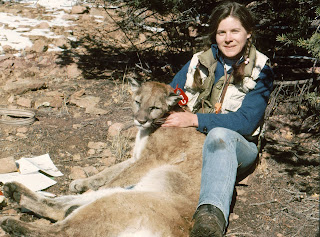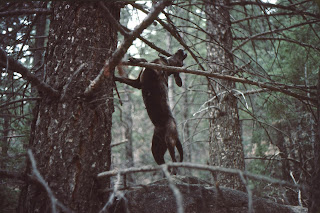We arrived back in Canon City to four days of poor tracking conditions. Each morning we went out looking for tracks in the spotty conditions. Finding nothing or only very old tracks we turned to more mundane activities in the afternoon. I did laundry. Chuck got his brakes fixed. Finally we got a day with about two inches of snow and headed out full of optimism! In the afternoon we found some tracks made the night before. The hounds took off with enthusiasm but their baying stopped abruptly at the bottom of the hill and they milled around trying to find the continuing track. The sun had already started melting the snow on the south slope and the enticing odor of cat evaporated with the snow. After two more days of poor tracking with a couple of abortive starts Gray and I drove back to Fort Collins and Chuck to his home. Alas, maybe our luck had changed for the worse!
A week later we arrived back in Canon City but the conditions were still pretty poor: warm afternoons with spotty snow. Our pattern of hunting was one or two of us accompanied by a hound would walk a promising area while the third person drove the truck around to meet the walkers at the end of the ridge or draw. The first day back we had no luck whatsoever. The second day we found two sets of pretty good medium-sized tracks and spent all day on them going through an area with evidence of a herd of elk and lots of deer. Unfortunately we ended up with nothing.
The third day, ah, that was different! We drove up what was called the Willow Creek-Locke Mountain road which was near the area we had found the tracks the day before. We found nothing on the way up but as we were driving back we found two sets of fresh tracks that had crossed the road after we had driven up it! Our quarry of yesterday, but this time fresh! The hounds raced right up the bare south side of the hill, down the snowy north side and up the next ridge. They treed a medium-sized lion in pretty short order. I darted her in the flank and she immediately bailed out. With the spotty conditions we had trouble following her with the hounds on leashes so against my better judgement Chuck turned Pup loose on her trail. He with his other two leashed hounds, Gray and I charged after them both. I heard Pup bark "treed" close by and reached Pup just as she was starting to chew on the comatose lion.
We had thought we were following two young lions that were travelling together after they had become independent from their mother. Lions usually stay with their mother for a year and a half to two years learning how to hunt. Like mothers everywhere her patience only lasts so long and at some point she gets grumpy and drives them off. While following the tracks it looked as if one lion had playfully hopped up on a log then jumped down to the other side and in another place one set of tracks went around in a circle.
It turned out the first lion we treed was an older female who was heavier than we had thought. The reason she had been able to travel as far as she had after she had been darted was because she had gotten a light dose of the drug. She was still putting up with the antics of her almost full-grown offspring.
 |
| Geraldine after we finished working on her |
While Gray and I worked on her Chuck took the hounds to circle around on the north side of the hill to try to find the other lion which we assumed must be her older kitten. They had a pretty short chase and treed it in about 20 minutes just as we finished working on the cat I named Geraldine.
Chuck told me he thought the lion was a young tom from the rear view he had gotten. In mountain lions it's pretty hard to tell, particularly with their furry winter coat.
I asked him for the charges that I had given him to hold when I was getting ready to dart Geraldine. Chuck smacked his head and said he had set them down while he was untying the hounds for the second chase but forgotten to pick them up. He and Gray traipsed back to where we had left Geraldine to look for them. I stayed and talked to the antsy lion and kept the hounds pacing around the base of the tree to keep it up there. It had turned cold so Chuck had built a small fire so I could keep warm. He returned about 45 minutes later with the charges but said he had not seen Gray.
I went ahead and darted the lion which turned out to be a young 80-pound female. She bailed out after she was darted but soon succumbed to the drug. While I was talking to her in the tree her eyes looked like they were lined with kohl so I had decided to name the lion either Cleopatra or Tut. Cleopatra was the appropriate choice! Gray found us just as we finished processing her and we returned to the truck together. When we passed the place where we had left Geraldine we could see from the tracks that she had rolled a ways down the hill, then gotten up and run off.
We were satisfied with a good day's hunting and went back to camp for the stew that had been simmering in the crock pot. We discussed what our next move would be. The conditions continued to be poor so we decided to spend the next few days chatting with the ranchers and guide-and-outfitters in the area.
One cantankerous old rancher who wanted to kill any lion we got on his ranch told us he had put out coyote-getters, baited cyanide traps that kill coyotes, but also dogs, bears and the occasional mountain lion. This had Chuck worried so we checked with all the other ranchers in the area. No one else admitted to using the traps so we decided just to stay away from the old codger's ranch.


























